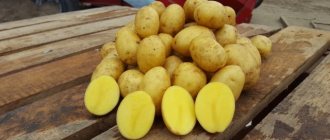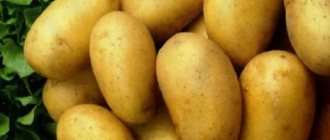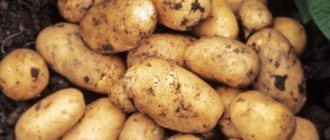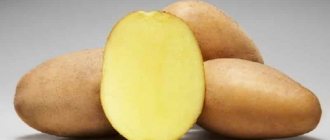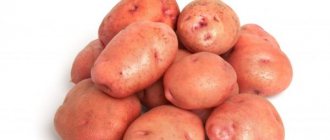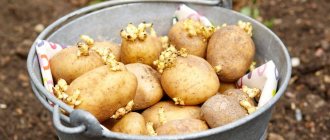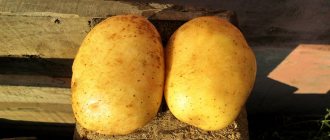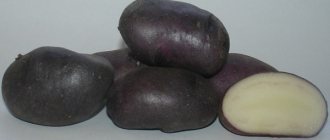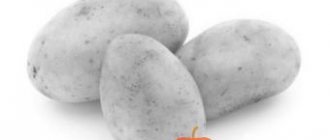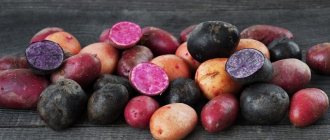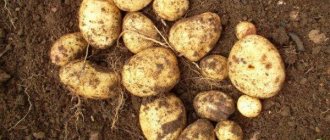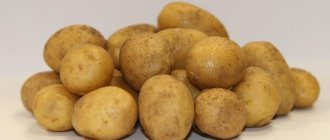Late potato varieties resistant to drought: description and cultivation characteristics
When choosing potatoes for seeds, choose early and late varieties.
Early potatoes yield faster, but the taste often suffers. Late varieties are more tasty and productive. The most popular late potato varieties: Kubanka, Repanka, Impala, Krone, Evolution. To avoid potato degeneration, it is recommended to update the seeds annually. They should be purchased at vegetable markets or in specialized stores.
Potatoes of the Kubanka variety are recommended to be grown in regions with an arid, warm climate. This type of potato is widespread in Kuban and Ukraine. It is excellent for growing both on a personal plot and in fields for industrial consumption.
The main qualities inherent in potatoes of this variety:
- large tubers, weighing 90-130 g, oval in shape;
- the fruits are neat, with white pulp;
- the peel is smooth, medium thin, without grooves, and has a light yellow color;
- there are few ocelli and they are shallow;
- It contains many useful amino acids and proteins, while the starch content is moderate.
Kubanka is a product of Russian selection, a medium-late variety. The best yield is observed at the end of the growing season.
Usually, from one hectare you can get about 200 centners of potatoes of this variety. Kubanka is insensitive to weather changes and easily tolerates short-term drought and heat.
These potatoes have consistently good yields year after year.
The potato bush is low and erect. It has small green leaves and large white inflorescences appear during the flowering period. From each bush you can collect about 12 -15 potatoes.
Planting in the ground is carried out in mid-late spring. Before planting, the soil is fertilized with ash or humus. After transplanting, it is recommended to feed the potatoes with organic fertilizers. During the season, you should hill up the potato bushes 2 times, forming a hill of soil around each one, in which the tubers will form.
When planting, the bushes are placed at a distance of 30 cm from each other. Throughout the season, it is necessary to pull out weeds that interfere with the normal growth of potatoes.
Kubanka is resistant to diseases: tobacco mosaic, common scab and cyst nematode.
Among the main advantages of this potato it is worth noting:
- high productivity;
- ease of care;
- resistance to temperature changes and drought;
- excellent fruit taste.
Kubanka has no disadvantages; this variety is excellent for growing.
These potatoes are popular in the southern and central regions of Russia, as well as Belarus. It is actively grown in gardens and farms.
The main indicators of this variety include:
- large fruit weight - about 130 g;
- potatoes have an oval-round, slightly flattened shape;
- the skin of the tubers is smooth and thin, has a pink-red color;
- there are few ocelli and they are superficial;
- It contains enough proteins and vitamins; there is little starch in the fruits - about 12–15%.
This potato belongs to the mid-late varieties; it has a fairly high yield - about 15 fruits per bush. The harvest is well stored, maintaining its taste and external properties. Turnip has a low and spreading bush with a large number of large leaves. This has a beneficial effect on the growth of the bush, since wide and numerous leaves protect the trunk and the ground around the bush from the sun and allow maintaining sufficient moisture in the soil.
The history of the origin of the potato variety "Kubanka"
The Kubanka variety was bred in Russia by breeding scientists. The vegetable is intended for cultivation in areas with hot and dry climates.
It is possible to obtain two harvests per season if tubers are planted early.
The variety is grown in Kuban and is widespread in eastern Ukraine. Potatoes are suitable for planting on farms, home gardens and vegetable gardens, as well as for industrial cultivation.
IMPORTANT: The seed material does not degenerate - root crops for planting can be collected from year to year.
Description of the variety
Kubanka varietal potatoes have the following characteristics:
- Resistance to heat and drought, as well as sudden changes in weather conditions and short-term frosts;
- The ripening period of the vegetable is 70-75 days;
- Weight of marketable root crops – 90-130 grams;
- High yield - about 220 centners per hectare;
- Starch content is 10-24%;
- Resistance to a large number of diseases;
- Good keeping quality and long-term storage;
- Yellow skin and creamy flesh;
- The vegetable grows in places with hot and dry climates.
The first root crops ripen 45 days after emergence. The highest potato yield is achieved after 2.5 months.
Potato varieties:
What potato varieties are best suited for planting in Kuban
In any region, varieties that are divided into early, mid-early, mid-season, mid-late and late are of great importance for growing potatoes. Assigning them to one species or another depends on how many days after planting you can start digging up the tubers:
- early - after 50–65 days;
- mid-early – after 65–80 days; and
- mid-season - after 80–95 days;
- medium-late – after 95–110 days;
- late - after 110 days or more.
Kuban farmers plant mainly early varieties for sale at the end of May-June. These are Impala, Early Zhukovsky, Udacha, Red Scarlet, Dita, Roko, Romano, Picasso, and others. They have also proven themselves well among gardeners.
I always plant several varieties, different in terms of ripening. It is difficult to predict what the coming spring or summer will be like. That is why you cannot plant just one. I plant early ones only to produce young potatoes. We eat almost all of it young. There is almost no space left for storage.
I will tell you about those varieties that I grew myself - I have something to tell about them.
Variety Impala
For example, I really like the Impala. This variety has never let me down. She gives birth well every year. I think that it is very suitable for growing in Kuban. Very early. The bushes are tall (up to 70 cm), the flowers are white. You can dig up the bushes 40-45 days after planting. This is a variety of Dutch selection. The tubers are large, there are no small ones. Tubers quickly gain weight. Gives a stable harvest even in dry, hot summers. The tubers have time to gain weight before the heat sets in. The tubers are large, beautiful, smooth, oval, all approximately the same size. The peel is yellow, the flesh is light yellow. The eyes are small. The number of tubers is 7-8, sometimes more. It boils well. You can’t call it particularly crumbly, but when cooking, the surface of the potatoes seems to crack slightly and looks appetizing. It is very tasty in puree, soup, or fried. Doesn't darken after cooking. Impala is resistant to some viruses, to potato nematode, moderately resistant to late blight of tubers, tops, and scab.
Variety Roko (Rocco)
I consider this variety to be successful for growing in the Kuban only with sufficient rain in May or with sufficient watering during tuberization. Dutch variety. It belongs to the mid-season variety, so its tuberization period is later than, for example, Impala. Therefore, it will grow well, and the tubers will gain weight with sufficient moisture. You can dig up bushes no earlier than 60-65 days, sometimes even later. It is believed that this variety reaches full ripening in 80-95 days. Roko's tubers are very beautiful in color, smooth, and have small eyes. In general, I plant it only because of the beautiful tubers.
